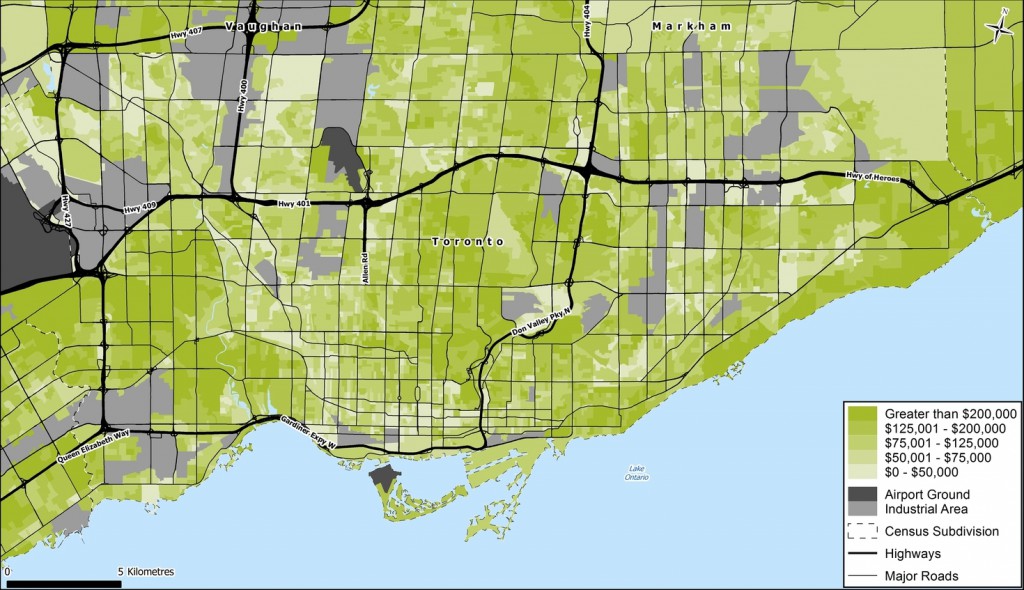
This map shows are the household employer pension plan values, by dissemination area, for the Greater Toronto Area. Note that the areas close to manufacturing employment centres tend to have very large pension values while the younger condominium dwellers between Bathurst and Spadina Street have not yet built up significant pension values.
When commercial real estate developer Cadillac Fairview wanted to redevelop its Sherway Gardens shopping mall in Toronto, it turned to WealthScapes. The financial database from Environics Analytics (EA) helped developers determine the disposable income of shoppers in the trade area, a crucial indicator for choosing what stores should be part of the retail mix.
WealthScapes was also tapped when the BC Cancer Foundation wanted to increase its donor network and sought data on the net worth of its contributors. By integrating WealthScapes data with the foundation’s database of nearly 500,000 past supporters, analysts determined the net worth of their neighbourhoods, which helped them identify donors with the potential to be converted into major contributors.
And when the Royal Canadian Mint wanted to better tailor its marketing efforts to coin collectors, it also turned to WealthScapes for data on household income and assets. The organization used the database to develop custom models that helped produce more personalized up-sell and cross-sell strategies targeting its current customers as well as prospective numismatists.
Data-driven marketing initiatives like these are becoming increasingly common across a range of sectors. At a time when marketers face challenges in understanding their customers—thanks in no small part to the sheer quantity of information available today—many are turning to a database originally created for banks and investment firms to help them develop sound business strategies and launch effective campaigns.
First launched in 2008, WealthScapes was designed to provide estimates on key assets, liabilities and wealth of Canadians at the dissemination area (DA) level. That first dataset consisted of 64 financial variables with measures such as disposable and discretionary income, savings and investments by type, RSP and TFSA components, mortgages, loans and credit card accounts. But over the past eight years, the number of variables has nearly tripled to 178, and the dataset has become popular not just among bankers and financial planners but with retailers, fundraisers, real estate developers and university administrators. WealthScapes is now used for target marketing, customer insights, media planning, site location studies and response analysis in addition to its traditional consumer finance-related applications.
Part of the growing interest in WealthScapes is its robust data sources. While some financial databases rely on just one source, EA analysts draw on more than 30 resources to produce its authoritative numbers, including the Bank of Canada, Equifax and Statistics Canada. The multiple sources allow analysts to match the best available control totals in Canada so the data will be endorsed by chief economists. With growing concerns about privacy, it may be surprising that such detailed financial data is available to marketers. But like its previous releases, WealthScapes 2016 was built using sophisticated modelling techniques and aggregated, privacy-compliant, small-area data.
Users in the financial sector have long found WealthScapes to be a valuable resource in helping them define, describe, profile and target their audiences. For example, a bank might use WealthScapes to compare the holdership, value and wallet sizes of their products to benchmarks in specific markets. This analysis lets the institution understand which financial products are performing well in terms of overall holdership rates and dollar value—as well as the size of the remaining opportunity.
But many financial users are discovering new applications. At Ontario-based Alterna Savings Credit Union, officials wanted to extract key data to help them acquire new customers and better connect with existing ones. Starting with the question “Who are our best customers?” Alterna marketers and EA analysts integrated member data with WealthScapes and other EA datasets to better understand their customers, calculate wallet share and determine opportunities for growth—by branch and financial product. Over the past two years, the credit union has leveraged these insights across its organization—from executives to front-line staff—to strengthen its relationship with current members and attract new ones. And with a data-driven view of their customers, branch managers could better communicate with them using messages that resonated with their concerns and values.
The popularity of WealthScapes beyond the financial sector has not been lost on its creators at EA. This spring, the Toronto-based firm launched two additional databases derived from WealthScapes that are geared to specific applications. WealthScapes Fundraiser features a selection of 31 income, wealth and expenditure variables to assess the charitable giving capacity and inclination of prospective donors. When the age of the prospect is known, users can leverage age-specific estimates of household income and liquid assets. Users can also append WealthScapes Fundraiser estimates to prospect lists for screening and predictive modelling. This approach allows charities and not-for-profits to identify neighbourhoods where residents are more likely to donate and have the giving capacity to make significant contributions.
WealthScapes Daytime, the other spin-off, focuses on 77 variables from the main dataset that help users better understand the consumer spending power and financial behaviour of an area during daytime hours as well as the daytime demand for financial services like ABMs. By using commuter flow and workplace information, WealthScapes Daytime accounts for the daytime population both at a work location (the commuting population) and at home (the non-commuting population). With this information users can locate households with high net worth but low income—typical of the increasingly large cohort of retirees—in areas with high at-home populations. In addition, it allows retailers and financial institutions to locate their outlets near centres of employment to reach busy consumers during the day.
To be sure, conventional demographic data like household income remains important for marketers. But WealthScapes offers greater insights into the wealth and spending patterns—as well as the liabilities and debts—of target consumers and suggests innovative ways to apply its data. For marketers launching a new product, fundraisers seeking bigger donations, and mall developers creating the optimal retail mix, a database that was once a banker’s best-kept secret is now helping organizations in a variety of industries achieve success. And the possibilities are limited only by the marketer’s imagination.
This article originally appeared in the August 2016 issue of Direct Marketing.


No Comment